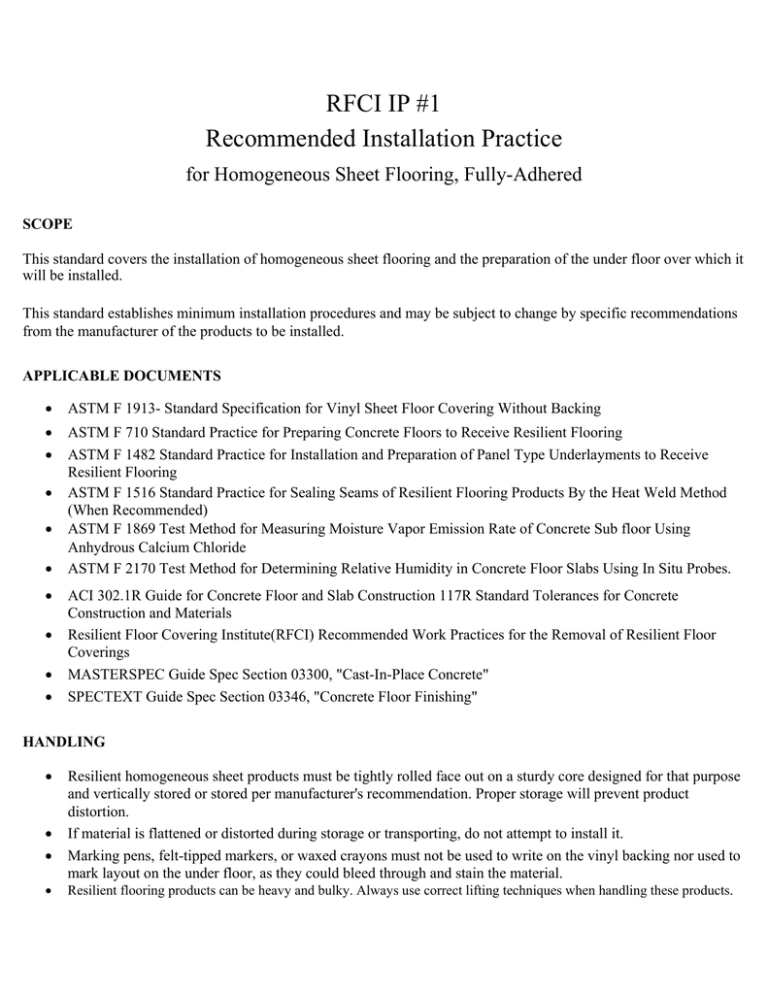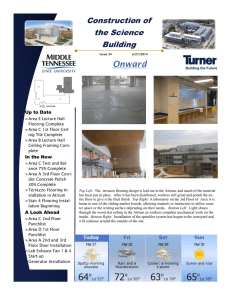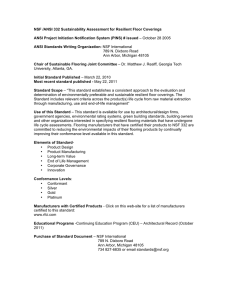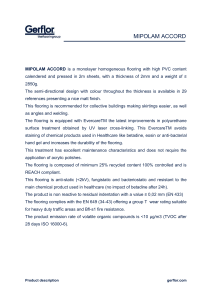Recommended Installation Practices for Homogenous Sheet
advertisement

RFCI IP #1 Recommended Installation Practice for Homogeneous Sheet Flooring, Fully-Adhered SCOPE This standard covers the installation of homogeneous sheet flooring and the preparation of the under floor over which it will be installed. This standard establishes minimum installation procedures and may be subject to change by specific recommendations from the manufacturer of the products to be installed. APPLICABLE DOCUMENTS • ASTM F 1913- Standard Specification for Vinyl Sheet Floor Covering Without Backing • • ASTM F 710 Standard Practice for Preparing Concrete Floors to Receive Resilient Flooring ASTM F 1482 Standard Practice for Installation and Preparation of Panel Type Underlayments to Receive Resilient Flooring ASTM F 1516 Standard Practice for Sealing Seams of Resilient Flooring Products By the Heat Weld Method (When Recommended) ASTM F 1869 Test Method for Measuring Moisture Vapor Emission Rate of Concrete Sub floor Using Anhydrous Calcium Chloride ASTM F 2170 Test Method for Determining Relative Humidity in Concrete Floor Slabs Using In Situ Probes. • • • • • • • ACI 302.1R Guide for Concrete Floor and Slab Construction 117R Standard Tolerances for Concrete Construction and Materials Resilient Floor Covering Institute(RFCI) Recommended Work Practices for the Removal of Resilient Floor Coverings MASTERSPEC Guide Spec Section 03300, "Cast-In-Place Concrete" SPECTEXT Guide Spec Section 03346, "Concrete Floor Finishing" HANDLING • • • • Resilient homogeneous sheet products must be tightly rolled face out on a sturdy core designed for that purpose and vertically stored or stored per manufacturer's recommendation. Proper storage will prevent product distortion. If material is flattened or distorted during storage or transporting, do not attempt to install it. Marking pens, felt-tipped markers, or waxed crayons must not be used to write on the vinyl backing nor used to mark layout on the under floor, as they could bleed through and stain the material. Resilient flooring products can be heavy and bulky. Always use correct lifting techniques when handling these products. SITE CONDITIONS A permanent HV AC system must be operational before installing the resilient flooring. Resilient flooring should be installed only after other trades have finished. Keep all resilient flooring and accessories at the job site and any other installation related products at room temperature (min. 65°F/18.3 C and max. 100 OF/37.8 C) for at least 48 hours before, during, and after the installation. When using reactive adhesives, such as epoxies, the room temperature should not exceed 85°F/29.4°C during installation. Thereafter, temperature should be maintained above a minimum of55°F/12.8 C. Excessively high or low interior air relative humidity will influence curing of floor patching materials and adhesive open times. Those conditions during installation should be avoided. Resilient homogeneous sheet flooring products are intended for interior locations only. Underlayments utilized should be installed and prepared according to the specific underlayment manufacturer's written instructions. Use appropriate underlayment as recommended by the flooring manufacturer. ENVIRONMENTAL CONDITIONS Consult appropriate Material Safety Data Sheets (MSDS) for proper handling of sundry items. During installation, the room should be well ventilated. Maximize fresh air ventilation by utilizing exhaust fans, at point of use, and by opening windows and doors as necessary. Because some materials used during the installation of resilient flooring may be flammable, make sure no sources of ignition or open flame exist near the use of those materials. Excessively high or low interior air relative humidity will influence curing of floor patching materials and adhesive open times. Those conditions during installation should be avoided. PLANNING Problems and potential causes of dissatisfaction can be avoided if discussions are held during the project bidding phase amongst the suppliers and trades. Each room should be carefully measured prior to installation to insure adequate material. It is common practice that a minimum 2-3 % additional flooring material or "Attic Stock" be included to cover future repair and/or building plan adjustments. For areas subjected to concentrated static and/or dynamic loads, it is recommended that a hard-set adhesive be utilized under the flooring materials where subjected to concentrated static and/or dynamic rolling loads are involved. Refer to specific manufacturer's recommendations. If an underlayment is being installed or material is installed over an existing floor (check individual manufacturer's literature to verify this is permitted), doors that may not have sufficient clearance will require trimming. Determine who will be responsible prior to the installation. Use of recommended installation accessories (e.g. adhesive) will insure proper performance and product warranty. Prior to installation, there should be an agreement as to who will move items such as furniture, appliances, etc. Appliances requiring utility disconnect (water, gas, etc.) may be subject to applicable local code requirements. Disconnect/reconnect arrangements are to be determined in advance by the end user or general contractor. Castors and/or glides utilized on furniture or equipment should distribute weight sufficiently to allow static loads to conform with ASTM recommendations (less than 250 psi). Verify in advance as to who will remove, recycle and/or dispose of the existing flooring, if applicable, as well as the remnant scraps. The end user should be shown the proposed installation layout including any intended seam locations. The end user should be provided a copy of the appropriate maintenance and warranty information pertaining to the product selected. LAYOUT The flooring dealer or contractor should provide a layout drawing for the intended installation to include the following information: END USER: • Name • Address and Telephone Number (Contact) • Directions to Job Site • Room Location • Date of Drawing • Scale of Drawing • Location, Swing and Clearance of All Doors • Existing Floor/Under Floor Conditions • Notation Regarding Who is Responsible for Preparation and/or Removal of Existing Floor/Under Floor • Name of Manufacturer, Product Style and Pattern to be Installed • Product Quantities Required • Seam Layout Including Pattern Match Requirements (if required) • Location and Type of All Edge Moldings and Base Required SEAMS: Seam visibility shall be kept to a minimum, positioning the seams wherever and whenever possible so that: • • • • Main traffic runs parallel to--rather than across--the seam. Light does not strike directly across the seam. The seams are away from areas subject to pivoting traffic. In doorway openings connecting adjoining rooms, parallel seams are required. END USER SIGN-OFF: The end user should be shown or provided a copy of the layout drawing for approval prior to installation. SUB FLOOR RECOMMENDATIONS & PRECAUTIONS Typical under floors, provided they are structurally sound and properly prepared to receive resilient flooring, such as those listed below are considered satisfactory for use under homogeneous sheet flooring. Review flooring manufacturer's installation manuals for specific recommendations that may provide more guidance or detail beyond the recommendations provided here. • Clean, dry, fully cured concrete slabs on all grades (coatings, sealers, curing compounds present may require nonchemical removal). • All American Plywood Association underlayment panels rated as underlayment grade with a fully- sanded face • Sturd-I-Floor rated veneered plywood, wafer or oriented strand board • All veneered, OSB, chipboard, etc. underlayment panels recommended and warranted by the panel manufacturer for use as resilient flooring underlayment • Some non-cushioned resilient flooring materials may be peffi1itted as a suitable under floor by some manufacturers. • Ceramic tile, terrazzo, marble • • Polymeric-poured (seamless) floors .Steel, stainless steel, aluminum Trowelable underlayments, patches and levelers NOTE: ALL WOOD SUB FLOORS MUST BE DOUBLE-LAYER CONSTRUCTION, SUSPENDED AT LEAST 18 INCHES ABOVE GRADE AND HA YE ADEQUATE CROSS-VENTILATION. DO NOT install resilient homogeneous sheet floor products over any of these under floors: • Asphalt tile or asphalt-based adhesive, or surfaces containing any type of residual adhesive • On-grade or below-grade concrete under floor that is subject to excessive moisture or hydrostatic pressure • Thick foam-backed or vinyl-backed resilient floor covering over 100 mils total thickness • Loose-laid or perimeter-fastened existing floor covering • Self-stick vinyl or composition floor tile • Mineral composition floor tile • Existing resilient floor covering that is heavily textured or embossed, unless properly filled • • • Existing cushioned resilient flooring Strip-wood or plank under floors Radiant-heated floors with surface temperatures greater than 85°F (29.4 C) Linoleum UNDER FLOOR PREPARATION • Moisture testing must be conducted on concrete. Common tests are ASTM F-1869 and/or ASTM F-2170 (see applicable documents). Generally acceptable ranges are 3.0 lb. MVTR or below for ASTM F-1869 and/or less than 75% RH per ASTM F-2170. • The under floor must be smooth, clean and dry. • Documented moisture and pH testing must be conducted on ALL concrete substrates, regardless of the grade level and age. • All dirt, wax, vinyl dressings, dust or other substances must be removed. • Bond tests as recommended by the flooring manufacturer also need to be performed and documented prior to the start of the installation. • Cracks should be patched with an appropriate patching/leveling compound. • Any wood stain, solvent or oil-based spills must be completely removed. Small stains can be covered with aluminum foil to prevent stain-through of the vinyl. • All fasteners must be secure and set flush with the surface of the under floor. • All existing resilient floor coverings with surface irregularities, unevenness or deep embossing must be covered with a minimum 1/4 inch (6.4 mm) underlayment or over-layed with a cementitious latex embossing leveler. Otherwise, the existing resilient floor must be completely removed. Check specific manufacturer recommendations. • All ceramic-tiled floors must be over-layed with a cementitious latex patching compound designed and warranted for such a purpose, which must be allowed to fully cure prior to the installation of the sheet vinyl product. RFCI RECOMMENDED WORK PRACTICES RFCI's Recommended Work Practices for the Removal of Resilient Floor Coverings are a defined set of instructions addressed to the task of removing all resilient floor covering structures. A copy of these instructions can be obtained by contacting the manufacturer of the product being installed or by downloading the Recommended Work Practices for the Removal of Resilient Floor Coverings at the Resilient Floor Covering Institute website: www .rfci.com WARNING: Do not sand, dry-sweep, dry-scrape, drill, saw, bead-blast or mechanically chip or pulverize c existing resilient flooring, backing, lining felt, asphaltic "cut-back" adhesive or other adhesive:. These products may contain asbestos fibers or crystalline silica. Avoid creating dust. Inhalation of such dust is a cancer and respiratory tract hazard. Smoking by individuals exposed to asbestos fibers greatly increases the risk of serious bodily harm. Unless positively certain that the product is a non-asbestos containing material, you must presume it contains asbestos. Regulations may require that the material be tested to determine the asbestos content. MOLD and MILDEW Issues concerning mold and mildew are gaining increased attention from both residential and commercial property owners, as well as the public at large. In virtually all situations, if there is a mold issue, there is an excessive moisture issue. In order to prevent, control, or remediate mold and mildew, one must first identify, evaluate, and eliminate the source of excessive moisture. Prior to removing an existing resilient floor following the RFCI Recommended Work Practices for Removal of Resilient Floor Coverings (unless state or local law requires other measures) or installing a new floor, if there are visible indications of mold or mildew or the presence of a strong musty odor in the area where resilient flooring is to be removed or installed, the source of the problem should be identified and corrected before proceeding with the flooring work. Visible signs of mold or mildew (such as discoloration can indicate the presence of mold or mildew on the sub floor, on the underlayment, on the back of the flooring, and sometimes even on the floor surface. If mold or mildew is discovered during the removal or installation of resilient flooring, all flooring work should stop until the mold or mildew problem (and any related moisture problem) has been addressed. Before installing the new resilient flooring, make sure the underlayment and/or sub floor is allowed to thoroughly dry and that any residual effect of excessive moisture, mold or structural damage has been corrected. To deal with mold and mildew issues, you should refer to the U .S. Environmental Protection Agency (EP A) guidelines that address mold and mildew. Depending on the mold or mildew condition present, those remediation options range from cleanup measures using gloves and biocide to hiring a professional mold and mildew remediation contractor to address the condition. Resilient flooring, because it is relatively non-porous, allows any mold and mildew on the flooring surface to be easily cleaned. Remediation measures may require structural repairs such as replacing underlayment and/or sub floor contaminated with mold or mildew as a result of prolonged exposure to moisture. The EP A mold guidelines are contained in two publications " A Brief Guide to Mold. Moisture and Your Home" (EPA 402-K-02003) and "Mold Remediation in Schools and Commercial Buildings" (EPA 402-K-01 -001). Appendix B of the "Mold Remediation in Schools and Commercial Buildings" publication describes potential health effects from exposure to mold, such as allergic and asthma reactions and irritation to eyes, skin, nose and throat. These publications can be located on EPA's web site at www.epa.gov/iaq/molds. INSTALLATION AND SEAMING HOMOGENEOUS SHEET FLOORING Make sure underfloor is ready for installation of the product, including making sure all molding has been removed and door clearances checked. Thoroughly sweep the sub floor to remove all dirt and debris. Once the material is unrolled and cut to fit, it should be completely installed within four hours. When seaming is required with homogenous products, the materials should be positioned reverse or non-reverse sheets for seaming as recommended by the manufacturer. The construction of typical homogenous products requires that the seams be cut using the recess scribing technique. The selvage edge of one sheet should be straight-edged or trimmed approximately 3/8 inch from the edge. Position the sheets in such a manner that the top sheet will overlap the previously straight-edged prepared sheet by approximately 1/2 inch. Once the sheets are positioned, fold back the sheets to expose the under floor. If recommended by the flooring manufacturer, apply the recommended seam adhesive in a 3 to 6 inch wide band, centered under the seam, using the recommended notched trowel. Follow by applying the appropriate field adhesive with a recommended notched trowel over 100% of the remaining exposed under floor. After providing sufficient open time for the adhesive, lay the straight-edged sheet into the adhesive first and then lay in the second sheet. Roll the adhered areas to within about 6 inches of the seam line with a 100 lb. three-section floor roller. Repeat this procedure for the remaining half of the floor. It is important to note that appropriate open time depends on several factors, such as: sub floor porosity, room temperature, relative humidity and amount of adhesive applied. Set the recess scriber to produce a net fit, not gapped or too full. Place the guide of the recess scribing tool against the straightedged piece and scribe the top sheet. Do not set the scribing needle too deep nor apply excessive force when scribing the seam. Cut the scribed line. Roll the seam area with a hand seam roller to bring the seam edges level. Re-roll the entire adhered area with the 100 lb. floor roller. Thoroughly clean the seam area and wipe dry.’ HEAT WELDING HOMOGENEOUS SHEET FLOORING • Seams must be heat welded. • Wait at least 24 hours after initial installation to allow the adhesive to cure before grooving the sheet product to receive the heat weld rod. Grooving depth is typically two-thirds the thickness of the product, or approximately 0.050 inches (1.3 mm) deep and should have a centered "U" shape. • Proper temperature of the heat welding tool is critical to the success. Heat welding is always dependent upon speed of application and temperature. Practice on a scrap piece of material to determine optimum speed and temperature- • After the welding rod has cooled, trim the applied welding rod in two steps. Always use a trim plate with a sharp spatula trim knife for the first pass. Trim weld rod flush with the spatula knife, being careful not to gouge the vinyl surface. If using a seam trimmer, make sure it is constructed to ensure a two-cut method. • If recommended by the resilient manufacturer, the trimmed weld rod may be glazed by either applying or playing heat over the surface or using a topical sealer; this step reduces the porosity of the weld rod. REPAIRS Small cuts can eventually gap open and collect debris. To repair cuts, clean dirt from the cut and compress the material. -Seam using heat welding or apply chemical seam sealer, if individual manufacturer permits under their repair techniques. If damaged area must be replaced, follow these steps: • If possible, the floor covering repair piece should come from the original installation. • Tape the repair piece over the damaged area and double-cut through both pieces of flooring. .Remove the damaged area and scrape the sub floor clean of adhesives- • Apply appropriate adhesive to the back of the repair piece and insert into the flooring. Roll the repair piece with a hand roller. • Heat or chemical weld the repair piece into the flooring as specified by the flooring manufacturer's recommendations. CLEAN UP AND FINAL FINISH If recommended by the manufacturer, any welded seam should be protected from dust and traffic by appropriate seam covers. It is wise for the end user to retain some "attic stock" or, at a minimum, larger scraps for repair work should it ever be necessary. Check appearance of entire installation. Use proper cleaner or solvent to remove any adhesive on the surface of flooring or walls. Latex adhesive, still wet, can be removed with water; when dry, with mineral spirits. Follow precautions on container label as provided by the manufacturer of the mineral spirits. It is recommended that all exposed edges of the flooring be covered. Use product coving, cove base molding or wood trim on the walls around perimeter of room and protective molding at doorways or areas where the new flooring will fit against an existing flooring. Use cap molding on wall if the flooring will be installed as coved installation. If it is not feasible to cover an exposed edge of the flooring with protective molding, such as around floor drains, expansion joint covers or areas where the new flooring meets an existing flooring, etc., use a reactive hard-set adhesive recommended by the manufacturer such as an epoxy or polyurethane adhesive to adhere the flooring in these areas. If the exposed edge of new flooring extends above an adjacent existing flooring, a protective molding must be used. Around fixtures such as tubs, toilets, etc., a good quality caulk must be used to seal the edge. Insert trimmings upside down between metal registers and flooring to form an insulating gasket or caulk. Louvers should be adjusted so hot air is not directed against floor. These simple precautions minimize the possibility of heat discoloration. Use the floor as little as possible for at least 24 hours after the completion to minimize indentation while adhesive sets. If other work is to be performed in the room, protect the floor covering with a heavy non-staining paper or other suitable material. Furniture and appliances should be equipped with rests sufficiently large to meet the static load limit recommendations. To move furniture and equipment across the floor, use plywood or hardboard panels smooth side down as a runway whether or not an appliance hand truck is utilized. It is not recommended to move heavy furniture or allow rolling load traffic on the floor for at least 72 hours after installation. The floors shall be maintained as specified by the flooring manufacturer. This typically involves an initial application of at least two coats of polish. Walk-off mats are recommended at all exterior entrance ways. CUSTOMER ACCEPTANCE Upon completion of the job, the end user should sign a Job Completion Ticket.




